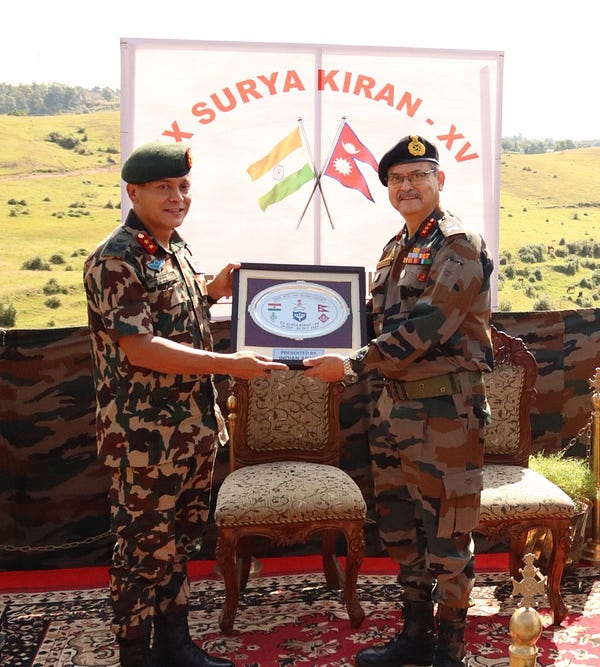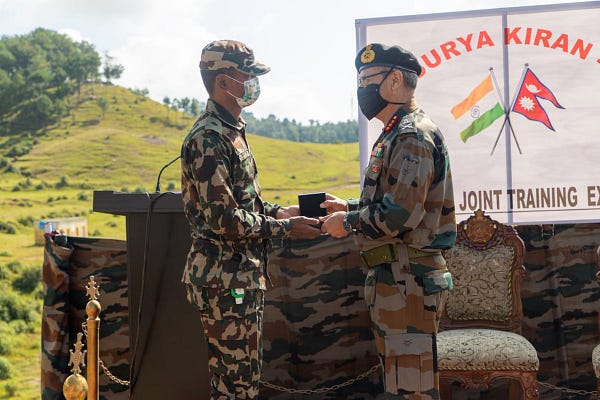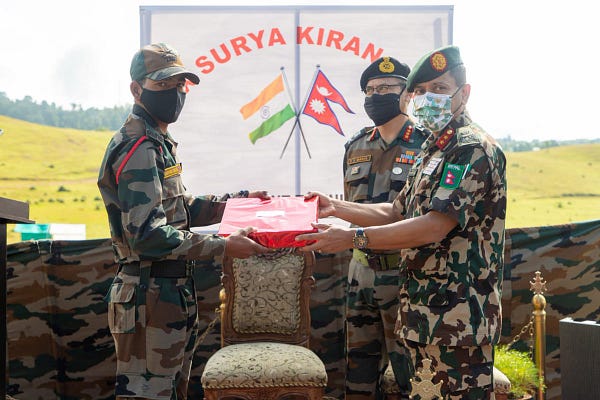Blending Borders #9
Blending Borders
A Fortnightly Newsletter
October 5th, 2021
Issue #9
This Newsletter explores ongoing issues and perspectives from India’s neighbouring countries, including - Sri Lanka, Bangladesh, Nepal, Myanmar, Bhutan, Maldives and Afghanistan.
In Brief, I discuss:- Vaccine updates, India-Sri Lanka exercise, Foreign trade statistics: India and its neighbours, Nepal’s green revolution, Bhutan 5G expansion, India-Maldives regional security, Myanmar-Afghanistan economic woes
The Raging Pandemic
The U.S Embassy in Sri Lanka released a statement saying nearly 800,000 doses of the Pfizer-BioNTech arrived in Colombo last week to continue its fight against COVID-19. The donation came as a gift from the American people, as stated in the report. Another report stated that the U.S announced on October 1st that it will be sending more than 8 million doses of COVID-19 vaccines to Bangladesh and the Philippines respectively. Out of this, 2,508,480 doses will arrive in Dhaka early next week, according to the report. The Dhaka Tribune reported that Bangladesh also received 792,000 doses of the AstraZeneca vaccine from Germany on October 2nd.
Meanwhile, China continues its vaccine diplomacy as it offered to provide 1 million doses of its Sinovac-CoronaVac vaccine to Nepal, said The Kathmandu Post. Myanmar received a batch of 4 million Sinopharm vaccines from China on October 2nd, according to a local report. In Sri Lanka, The Colombo Gazette said, a request was made by the Ambassador of Sri Lanka to China Dr. Palitha Kohona to officials from Sinopharm’s Beijing Institute of Biological Products Co Ltd, to establish a COVID-19 vaccine refilling plant in Sri Lanka. The officials included the Vice President of the Sinopharm HQ Shi Shengyi, the president of the Biological Products Division Zhu Jingjin, and the Vice President of the International Division Yan Bing. Chinese state media Xinhua reported that Bangladesh launched a special inoculation campaign for leading university’s teachers, students, officials and employees on October 4th. The campaign will last till the 17th of October and all persons will receive the Chinese Sinopharm vaccine.
Finally, according to this graph, Sri Lanka has a higher vaccination rate than the U.S and is likely to catch up with Germany soon.
Source: Twitter
India-Sri Lanka Military Exercise
In an effort to boost bilateral military relations, India and Sri Lanka began a 12-day exercise on October 4th with a focus on enhancing counter-terrorism cooperation. A report by NDTV stated that the aim of the exercise - called ‘Mitra Shakti’ is to elevate understanding of transnational terrorism, inter-operability skills, the conduct of joint tactical operations and mutual sharing of practices and experiences. The report quoted India’s Ministry of Defence saying, “the aim of the exercise is to promote close relations between armies of both countries and enhance inter-operability and sharing best practices in counter-insurgency and counter-terrorism operations”.
In Nepal, the 15th edition of the India-Nepal joint training exercise (that I talked about in issue #8), finally culminated after 14 days at Pithoragarh, Uttarakhand.




Bangladesh Naval Ship (BNS) ‘Somudra Avijan’ arrived in Visakhapatnam on a five-day visit to the Eastern Naval Command (ENC) on October 3rd. According to TOI, the visit was to honour the liberation of Bangladesh after the 1971 Indo-Pak war. But a series of activities are scheduled between the two navies including professional exchanges and interactions and cross-deck visits.
India’s $700 million Port Deal with Sri Lanka
Is India trying to counter China’s strategic influence in Sri Lanka? Mint reported that an Indian company entered into a $700 million deal to build a strategic deep-sea container terminal in Colombo. The terminal will be built next to a $500 million Chinese-run jetty at the Sprawling port in Colombo. The report quoted the Sri Lanka Ports Authority (SLPA) saying, “The agreement worth more than $700 million is the largest foreign investment ever in the port sector of Sri Lanka”. The new container jetty will have an annual capacity to hold $3.2 million containers.
Sino-Indian competition in Sri Lanka deepens as Indian Foreign Secretary Harsh Shringla will assess the progress of India-backed infrastructure projects in comparison with Chinese funded projects during his ongoing 4-day visit to the island nation, said The Print. The report quoted sources saying that India wants Sri Lanka not to “favour China at the cost of their relationship with India.”
Bilateral Foreign Trade Statistics: India and its Neighbours
Data Source: retrieved from the Department of Commerce - Ministry of Commerce and Industry
From the data stated above, India and Bangladesh share the highest value of trade compared to the rest of the neighbourhood. On that note, let’s talk about the infamous ‘Hilsa’ fish - a favourite of many in India. The Hilsa fish is a heavily demanded import product from Bangladesh. The Dhaka Tribune reported that the first consignment of 2000 kg’s of Hilsa (or Ilish) arrived in Tripura on October 1st. This is the first consignment sent to India after a ban on the export of the fish was lifted by Bangladesh after 10 years. According to the report, importers plan to import the fish in bulk from next week if demand for the product rises. Importers are hoping for prices to drop as more consignments reach Tripura markets.
Do read this journal article on the economic contribution of fish and fish trade in Bangladesh; it talks about the importance of Hilsa, which makes the highest contribution to the country’s total fish production. In this context, the article argues that Bangladesh can boost its economy by paying more attention to the fisheries sector, as per a study that highlights the contribution of fisheries production to Bangladesh’s trade.
Bangladesh’s Maritime Dispute with India
The Daily Star reported that Bangladesh made a formal objection to the UN Secretary-General over its maritime issues with India. The dispute goes back decades and it was even formally settled in 2014. But issues are still not resolved evidently. The problems pertaining to the baseline and continental shelf used by India in the 25,602 sq km of disputed waters in the Bay of Bengal. The baseline indicates a state’s exclusive economic zone; a state has certain special rights in this area of sea which is why the dispute remains an unresolved and sensitive issue for Bangladesh.
To know more about the maritime dispute between both India and Bangladesh, read this very detailed occasional paper by CNA on an overview of the Bangladesh v. India case history, a legal assessment of the ruling, and an analysis of the implications of the ruling for India-Bangladesh bilateral relations.
Nepal’s Green Revolution: GRID
The World Bank issued a press release on September 24th stating that the government of Nepal and development partners across the world endorsed the ‘Kathmandu Declaration’ to develop a strategic action plan for Nepal towards Green, Resilient, and Inclusive Development (GRID). The declaration was validated by Nepal’s Ministry of Finance, Asian Development Bank, Australia, European Union, Finland, France, Germany, International Monetary Fund, Norway, Republic of Korea, Switzerland, United Kingdom, United Nations, United States, and the World Bank. Under the Kathmandu Declaration, Nepal’s development partners have identified up to $4.2 billion in potential future support, in addition to the $3.2 billion in previously committed resources to support GRID.
The government and development partners intend to scale up support for such areas as sustainable tourism, renewable energy, cleaner transport and resilient roads, integrated solid waste management, sustainable forest management, watershed protection and water supply, biodiversity conservation, adaptive social protection, climate-smart agriculture, and sustainable cities. Partnerships and opportunities will be sought with the private sector to increase green investment and support job-creating small and medium enterprises and businesses in these and other areas.
Nepal’s GRID vision also emphasizes inclusion to enable women, indigenous groups, and vulnerable and marginalized communities to realize the benefits of a green, resilient recovery. This includes skills training and education opportunities to help citizens prepare for an evolving job market in a new green economy with greater opportunities for all Nepalis.
Finally, Xinhua reported that the Nepali government has banned the import of betel nut, pea, peppercorn and dried date as its forex reserves continue to decline amid a rise in imports.
Bhutan’s 5G Expansion
Telecommunications company Ericsson signed a deal with Bhutan Telecom to deploy 5G networks across the country - a technological breakthrough for the tiny Himalayan kingdom. A release issued by Ericsson said the aim is to deploy 5G to remote parts of the country and expand connectivity in these areas. Ericsson has previously partnered with Bhutan Telecom to supply mobile connectivity networks of older generations. The 5G deployment will also contribute to the Bhutanese Government’s efforts to bridge the digital divide in the country and drive innovative fourth industrial revolution (4IR), or Industry 4.0, opportunities for businesses, industries, verticals and the public sectors. Ericsson will work with Bhutan Telecom to explore related next-generation use cases tapping artificial intelligence (AI), augmented reality (AR), virtual reality (VR), automation and the Internet of Things (IoT). The 5G services are expected to roll out in the last quarter of 2021.
India-Bhutan Space Ties
India and Bhutan signed the implementing arrangement on the joint development of a small satellite for Bhutan on September 24th. The Indian Express quoted Ambassador of India to Bhutan Ruchira Kamboj saying, “Space sector cooperation is an exciting new area of bilateral partnership between India and Bhutan”. The agreement was finalised in a virtual signing ceremony between ISRO and the Department of Information Technology and Telecom, Bhutan.
Meanwhile, the Consumer Unity & Trust Society International (CUTS) organised a multi-stakeholder dialogue in Assam to promote cross-border trade through trans-boundary waterways between Bangladesh, Bhutan and India. According to a report, experts in the event said that participation of private sector businesses and people in cross-border trade and transportation through inland waterways is necessary for sustainable development. They continued by saying that it is imperative to involve farmers, local traders, women, youth, non-government organizations and local indigenous communities in trade, navigation and cross-border transportation to reduce socio-economic and environmental concerns related to inland waterways.
India-Maldives Regional Security MoU
On September 30th, the Government of India and Maldives signed a Memorandum of Understanding (MoU) on regional security, safety and marine protection to augment marine safety in the region through cooperation in the long-range identification and tracking of ships (LRIT) System. The Maldives will also receive India's assistance in human resource capacity building. The LRIT system will enhance international vessel identification and vessel safety, and ensure the safety and protection of the maritime environment. Information will also be shared by the Indian National Disaster Center for LRIT, which the Maldives will now gain access to as part of the signed agreement.
According to The Economic Times, India and Maldives signed another pact on social housing units in the Maldives. The EXIM Bank of India signed an agreement with Fahi Dhiriulhun Corporation Limited (FDC) of Maldives to extend buyers credit of approximately $228 million for the construction of 4000 social housing units in Hulhumale Phase II. According to the report, the High Commissioner of India to the Maldives Sunjay Sudhir said that as Maldives’ comprehensive development partner, India had extended over $ 2 billion in concessional loans to undertake infrastructure development projects. Apart from this, assistance was provided for undertakings in the social sector projects to augment Fisheries sector capacities, construct a Cancer Hospital and establish Water and Sanitation network in 34 islands of the Maldives. The Housing Agreements signified India’s largest foray yet into the high priority Housing Sector of the Maldives.
Myanmar and Afghanistan: A case of Worsening Economies
Myanmar and Afghanistan bear similar consequences as a result of their fate. With the coup takeover in the former and Taliban takeover in the latter, both countries are faced with a dire economic situation and deprivation of human rights. Myanmar’s currency has reportedly lost more than 60% of its value since the beginning of September and this has led to rocketing fuel and food prices. Richard Horsey, a Myanmar expert at the International Crisis Group was quoted saying, “This will rattle the generals as they are quite obsessed with the kyat rate as a broader barometer of the economy, and therefore a reflection on them”. In Afghanistan too, the dollar is losing its value and its causing economic chaos in the war-torn country. And like in Myanmar, food and fuel prices have shot up as a result, which is causing high levels of unemployment and poverty in Kabul.
Listen to this 3-minute podcast to gain a quick overview of the economic situation in Afghanistan presently and how the decreasing inflow of dollars is affecting locals.
Apart from a deteriorating economy, Afghanistan is reeling from the effects of media restriction. Human Rights Watch released a statement saying Taliban authorities have imposed a number of restrictions on media and free speech across the country. According to the statement, the Taliban Ministry of Information and Culture distributed media regulations whose provisions are so broad and vague as to prohibit virtually any critical reporting about the Taliban. Journalists are living in fear as Taliban security forces are detaining many found of flouting any regulations in their eyes. The suffocation of free speech is only adding to the ceaseless problems faced by locals ever since the Taliban regime took over.
Finally, check out this infographic depicting the various untapped mineral resources across Afghanistan; it reportedly holds more than $1 trillion worth of minerals and metals:
Source: Al Jazeera
Read the full report by Al Jazeera to look at the locations of various metals, valuable building materials and industrial minerals that exist across the country and the challenges that come with extracting these resources.
Suggested Reads
How to End Sri Lanka’s Food Crisis - Amita Arudpragasam - Foreign Policy
The Failure in Afghanistan Is Worse Than in Vietnam - William Lloyd Stearman - WSJ
Bangladesh: Rising tides of suffering - Sharif Jamil - Chatham House
Could Multinational Peacekeepers Prevent Worst-Case Outcomes in Afghanistan? - Ryan C. Van Wie - War on the Rocks
This Tiny Nation Is on a Fast Track to a Crypto Revolution - Jessica Karl - Bloomberg
Situation of human rights of Rohingya Muslims and other minorities in Myanmar - Report of the Secretary-General (A/76/312) - UNGA
That’s it for today! I hope you enjoyed this issue.
Thank you for subscribing to this newsletter. If you found it interesting, please share it with friends, colleagues and family.
This Newsletter is written by Ameera Rao, a Research Assistant at the Takshashila Institution. She has previously completed a BA (Hons) in International Relations from King’s College London.





